Plastic insert in the well: step-by-step installation instructions
Arrangement of an autonomous source of water intake at the site requires a careful approach. Particular attention should be paid to sealing the walls of the well. Agree, I would not want to receive contaminated water during the operation of the mine.
A plastic insert in the well, which is used to equip a new or restoration of an operated water intake point, helps to prevent this problem. In the article we examined in detail the pros and cons of such a solution, gave tips on choosing a polymer insert, and also described the procedure for installing it in a well.
The content of the article:
Purpose of plastic inserts
The main advantage of plastic structures is their practicality. Unlike concrete rings they are easy to transport to the place of assembly, which inevitably reduces shipping costs. When installing them, special equipment is not needed.
Plastic inserts protect against falling land falling into the well, seepage of ground and surface water, serve as an insulating barrier and an element for the formation of well walls.

The better the plastic, the longer the well will last.
Stiffeners perform two important functions in the design:
- Give extra structural strength.
- Serve as ground hooks, protecting from ascent.
Extra rigidity is needed to prevent deformations caused by soil movement. Mostly they occur for natural reasons. In this regard, concrete structures are more resistant to mechanical stress.
Performing the function of soil hooks, stiffeners prevent the ascent of the tank.If there were none, then with an increase in the level of groundwater, the capacity would inevitably rise. Such ascent leads to structural deformation.
Advantages and disadvantages
Plastic is resistant to natural biodegradation and can be in the ground for more than 50 years. At the same time, it combines the properties of strength, elasticity and tightness. Concrete products used in the construction of wells cannot boast of such characteristics.
In addition to resistance to decomposition, the walls of the plastic container are not affected by moss. If we compare plastic with concrete, then the latter tends to collapse under the influence of the environment.
As the temperature drops below zero, the water contained in the pores of the concrete begins to crystallize and increase in volume. As a result, porosity increases and the density of concrete stone decreases along with strength.
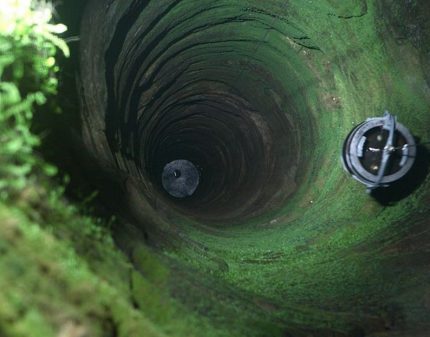
The design flaws include possible plastic damage by tree roots. Not recommended build a well or a well with a plastic shaft near them.
Another disadvantage is that with prolonged exposure to sunlight, the material becomes brittle. This leads to damage to the manhole cover if it is made of plastic. In addition to sunlight, the frost-resistant polymer is easily damaged in severe frosts.
It is not recommended to use plastic covers for wells if the temperature in winter drops below -25 ° C.
The advantages of plastic inserts include their reliability. Since with proper warming the temperature around the trunk within the zone of seasonal freezing does not fall to zero values, the risk of damage to plastic in tubular and shaft wells is minimal. Sealing failure may occur if the plastic insert is not properly secured.
During restoration and repairing an old well from concrete rings, the following fastening method is sometimes used:
- Lower the insert into the well.
- Fix it with anchors with rubber or silicone gaskets.
- The remaining space between the rings and the insert is filled with gravel, fine gravel or sand.
This installation leads to the need to replace gaskets, which eventually become unusable. With this installation method, damaged rubber parts are difficult. As a result, a gap is formed between the anchor and the insert. Through these slots, surface water enters the well, leading to a deterioration in the quality of drinking water.
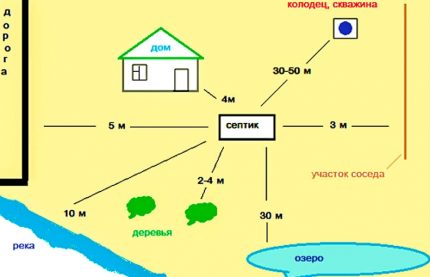
Through holes created by improper installation, bacteria can enter the well. A sure sign of depressurization is dark wet or dried smudges that go down from the anchors. If they are found, it is necessary to immediately treat the leak points with sealant. This procedure will have to be repeated as necessary.
The main causes of clogging wells
If the trunk is not sealed, then the causes of clogging or deterioration in the quality of water from the intake structure may be:
- Rare use of the source.
- Contamination from the outside.
- Wrong place.
The problem with stagnation of water at the points of water intake occurs, as a rule, in cottages. In houses where residents live year-round, there is a continuous renewal of water. This problem is easily solved if emptied, and then sanitize a well.

A serious mistake is the design of a source of water supply in ironized soils close to the surface. With this problem water becomes cloudy and takes on a noticeable rusty tint.
They solve the problem by installing a multi-level filtering system. In addition, the concentration of iron can be increased in water. This makes it unsuitable for drinking purposes without pre-cleaning.
How to choose an insert in a water supply well
When planning a purchase of a plastic “sleeve”, it is necessary to evaluate two main selection criteria: insert diameter and polymer thickness.
Insert diameter. If there is a ready-made well shaft, the insert should be of such a diameter that there is a distance sufficient to fill fine crushed stone, sand, or to fill with mortar to the edges of the foundation pit.
The distance from the edge of the pit to the corrugated insert must not be less than 20 cm. The diameter of the insert is determined from this.
Plastic thickness. The thicker it is, the stronger the structure, but this one affects the cost of a running meter. It is not worth saving, acquiring a too cheap option, since if the walls are damaged, you will have to dismantle the entire structure.

When using the elements of the stairs can damage the plastic walls, however, if the source of water has a large depth (4-5 m or more), then you can not do without them. If the aquifer is located in bedrock, then a permit will be required to install the water intake facility.
Restoration of the old well: progress
Plastic inserts can be installed directly in the well, or in an existing concrete well. Both installation options will be considered. First, the restoration process of an existing well.
This requires a minimum amount of time, since the bulk of the work has already been done.Drilling a tubular well from scratch requires a lot of effort. It’s important to choose the right place. The life of the well largely depends on this.
Before starting work, it is necessary to pump out water and clean the walls of the old well. This can be done with an ordinary spatula, going down to the bottom of the mine. This must be done if the distance between the insert and the concrete rings is filled with concrete.
Filling with a solution completely solves the problem with the strength of the structure, but makes it motionless. With this method, reuse of the insert is not possible.
Fixing with crushed stone or sand allows for simple dismantling, which will make it easy to fill up an old well. At the same time, no concrete structures remain on the site. Everything is dismantled and has the ability to transfer.
If the well is not overgrown with moss, then it is not necessary to clean its walls. After cleaning the walls, the old drainage must be completely removed. As a rule, gravel of different fractions is used for filtration.
After removing the crushed stone, you can proceed to install the insert. First you need to assemble it correctly. The individual segments are interconnected using sealing rubber parts. The connection method is similar to assembling sewer pipes, but on a larger scale.

Depending on the length of the structure, it can be installed manually or with the help of equipment. Lower it carefully. It is necessary to ensure that there is no sharp impact on the bottom of the mine, since plastic can crack when exposed to mechanical stress. At the next stage, the insert is fixed in the well.
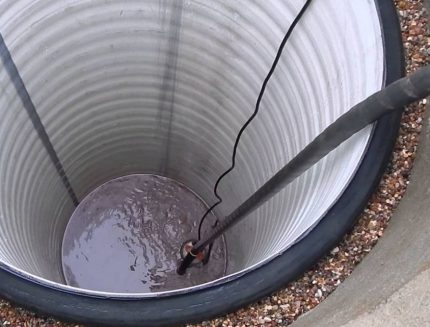
If the diameter of the well is slightly larger than the insert, then the distance is poured with a mortar with a cement or gypsum base. To knead the binder, you need a sand-gravel mixture, a direct binder and water. For the solution, it is necessary to mix three parts of ASG and one part of cement.
Water is added gradually, its amount directly depends on the humidity of the ASG. The finished solution is poured between the insert and the well along a special trough, which is a sheet of bent tin. After pouring, it is necessary to leave the well for 2 to 3 weeks until the solution solidifies completely.
Arrangement of a new water intake point
Consider the step-by-step technology for creating a well using a plastic “sleeve”. All work conditionally divided into three stages.
Preliminary planning and layout
If the site does not yet have a water source, then it is better to give preference well drilling. Professional drillers will build production in one / two days. These services can be ordered from specialized companies or firms engaged in drilling wells in the private sector.

Before starting work, it is worth interviewing neighbors who have their own farm well or well. The information obtained from them will help determine the approximate depth of production, the mark of the water mirror, and the presence of a water trap if it was encountered during the construction of neighboring sources.
In addition to this requirement, you must select a suitable location on the site. The source of drinking water should not be located near the septic system or farm buildings for the maintenance of subsidiary plots.The minimum distance of the marked objects is 25 m.
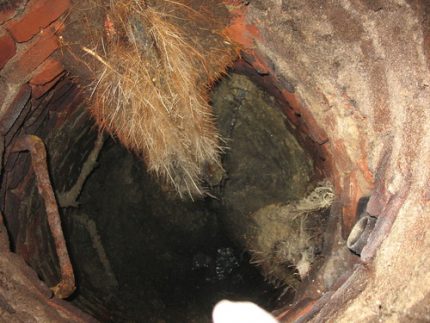
After marking and drilling, the insert segments are assembled into a single unit. This process is simple. Everyone can handle it. The segment assembly process has already been described. Unlike the previous method, concrete rings are not used here. A plastic insert is placed in a pit and sprinkled with rubble. The following is a filter device.
Installing a bottom filter
The bottom filter consists of several layers. If the bottom of the excavation is buried in fine or dusty sand, then the first one is a wooden lattice or a perforated shield from the board.
He sank to the bottom. On top of it place a piece of geotextile, cut to the diameter of the mine. It will perform the function of fine cleaning instead of sand. The material is easy to handle, but requires replacement as it becomes clogged.
Crushed stone is placed on top of the geotextile in the following order:
- Layer of crushed stone of small fraction 15 - 20 cm.
- Coarse gravel layer of large fraction 10 - 15 cm.
This avoids the ingress of fine sand suspension and gravel into the produced water. The bottom filter device is especially important if a pump is installed in the well, as the listed contaminants are able to disable the unit.
Crushed stone spills out to the bottom of the well with buckets. It is necessary to control the uniformity of distribution bottom filter - it affects the quality of the water.
Inspection and adjustment of equipment
The first start-up should be done only after making sure that the equipment is connected correctly. Do not use water for drinking purposes immediately after installation. It is necessary to remove the dirty fluid accumulated in the well by the pump, and with it the sediment that has got into the mine when the tab is installed is removed.
To remove water, it is necessary to lower the pump hose to the bottom of the well and pump water into a container in a personal plot. In the future, it can be used for irrigation.
If there is no storage tank, then you can drain the water directly into the ground, but at a considerable distance from the well. Only after these steps can the pump be connected to the domestic water supply system.
Maintenance and cleaning of the well
No matter what material the well is made of, it needs cleaning and system care. It is necessary to do a periodic inspection, as debris can get into the mine. This can lead to clogging and decay of the water at the intake point. In such cases, the mine is cleaned and water is repeatedly pumped.
Another cleaning method is to replace the bottom filter at the bottom of the well. If this element becomes clogged, then the water becomes cloudy and musty. To prevent such situations, it is necessary to change the gravel and geotextiles at the bottom of the well.
The popular method of cleaning is the addition of a small amount of potassium permanganate to the well. It kills microorganisms that live on the surface of stones. After such a disinfection, water from the structure must be pumped out several times. If you do not clean the well and neglect disinfection, then over time the water will become worthless.
Conclusions and useful video on the topic
The roller demonstrates the process of installing a plastic insert with the subsequent preparation of the water intake structure for operation:
How to make a bottom filter for cleaning well water:
In some places, own water intake is the only way to get drinking and industrial water. The use of a plastic insert can extend the service life of the structure, which means that it saves on re-drilling or digging a new one.
With proper installation, the insert can be reused if the well becomes unusable. This is a useful acquisition that reduces the cost of well equipment.
There is something to supplement, or there are questions about the use of a polymer insert for a well - you can leave comments on the publication. The contact form is located in the lower block.

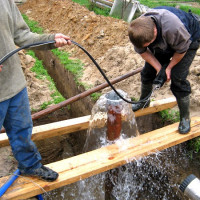 Do-it-yourself flushing of the well after drilling: step-by-step briefing on the work
Do-it-yourself flushing of the well after drilling: step-by-step briefing on the work  How much does it cost to dig a well under water: a list of necessary works and their prices
How much does it cost to dig a well under water: a list of necessary works and their prices 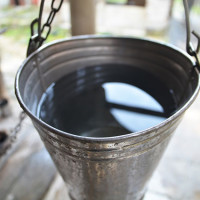 Well or well - which is better? Detailed comparative review
Well or well - which is better? Detailed comparative review  Do-it-yourself well: a detailed overview of self-construction
Do-it-yourself well: a detailed overview of self-construction 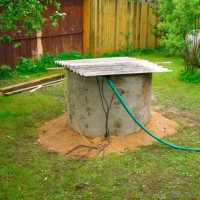 A do-it-yourself well in a country house: a guide for arranging a typical well from rings
A do-it-yourself well in a country house: a guide for arranging a typical well from rings  Arrangement of a well with a caisson: phased instruction + analysis of technical nuances
Arrangement of a well with a caisson: phased instruction + analysis of technical nuances  How much does it cost to connect gas to a private house: the price of organizing gas supply
How much does it cost to connect gas to a private house: the price of organizing gas supply  The best washing machines with dryer: model rating and customer tips
The best washing machines with dryer: model rating and customer tips  What is the color temperature of light and the nuances of choosing the temperature of the lamps to suit your needs
What is the color temperature of light and the nuances of choosing the temperature of the lamps to suit your needs  Replacement of a geyser in an apartment: replacement paperwork + basic norms and requirements
Replacement of a geyser in an apartment: replacement paperwork + basic norms and requirements
In truth, in addition to ease of delivery and conditional durability, I do not see any more pluses. The mechanical strength of this design is in doubt. And if next to such a well, a heavy machine gets tons of commercials for 8-10? Not the fact that the earth will not "go" and will not crush the wall. Therefore, only reinforced concrete rings, they serve for at least 50 years, even if everything is covered with moss and other things.
Do you start the movement of tectonic plates from the fact that the machine will stand next? And how often do you drive trucks close to the well?
Gennady, even longevity is doubtful. If the well is shallow and the water freezes, then the plastic will crack in a couple of years. Well, the most important drawback that I see is in danger to health. Plastic still breaks down and particles, small ones, which then cannot be retained with the filter, fall into the water. If cement is still a stone and is easily excreted through the gastrointestinal tract, then in the case of plastic, it, or rather particles, can damage the kidneys. I don’t want to be treated and even keep water in the garden in metal cans.